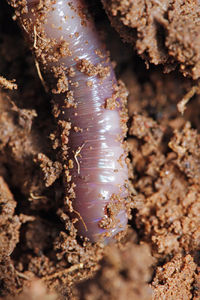Bacteria and earthworms
Introduction
Earthworm guts provide a unique anaerobic environment in the soil ecosystem. Microbe-containing soil is ingested, and then the soil undergoes a series of physical transformations that stimulate microbial activity. First, there is an initial influx of moisture and carbon from mucus excreted by the earthworm, and the soil pH is neutralized. As the soil becomes homogenized during the initial phase, microbial activity increases. Much of the water and nutrients are reabsorbed by the earthworm before excretion [1]. Both the gut microbes and the earthworm contribute to the decomposition of nutrients in the soil, and they both benefit from this process. This is called a mutualistic digestive system [2]. This relationship can involve any soil-dwelling microbe, but those belonging to the Rhizobiales order seem to be most involved with certain processes that will be described below [3]. Earthworm gut communities are particularly interesting due to their involvement with the production of greenhouse gases [4] and as hotspots of horizontal gene transfer activity [5].
Biological Interaction and Niche
Interactions between earthworms and gut microbes
The interaction between bacteria and earthworms may only be mutually beneficial for some types of bacteria. A broad survey of the microbial diversity microbes through the earthworm digestive process found that the abundance of bacteria belonging to δ-proteobacteria and the Cytophaga Flavobacterium group increased following digestion, while the abundance of α-, β-, and γ-proteobacteria decreased [6]. More recent studies have revealed that Rhizobiales species (an order nested within the α-proteobacteria) are highly involved in the production of N2O gas from earthworm guts [3]. Highly specific interactions seem to be rare, however, at least one instance has been documented between Eisenia fetida , a composting earthworm, and members of the Acidovorax genus [7]. The anaerobic nature and relatively high availability of nutrients of the earthworm gut stimulates the microbial process of N2O production via denitrification [4].
Environmental Niche
Microbial associations with earthworms can be found in any terrestrial soil ecosystem that worms inhabit. Earthworms fall into three different categories depending on their location and feeding strategies: (1) Epigeic earthworms live on the surface of the soil and feed on decaying litter, (2) endogeic earthworms live in the top layer of the soil and feed on the rhizosphere, and (3) anecic earthworms live deeper than the endogeic species and feed on decaying litter that they can pull down through permanent burrows [2]. For more information on the ecological role that earthworms have in the soil environment, see Compost pile and the Biological Factors: Soil Fauna section in Soil environment and physical factors controlling microbial activity.
The intestinal ecosystem is known to favor the production of N2O by microbes via nitrogen cycle pathways [8]. The earthworm gut itself is anoxic and high in organic substrates from the ingestion of soil. The anaerobic conditions favor alternative terminal electron acceptors, such as nitrate or nitrite, and this leads to the production of N2O or N2[4][9]. See the Nitrogen cycle including GHG for more information on denitrification and the production of N2O.
Microbial processes
Many of the microbes that pass through the earthworm gut appear to be transient and are simply eaten by the earthworm as a means to acquire nutrients. However, some microbes react well to the anoxic, moist environment they encounter inside the digestive tract and become quite active. This results in a complex mutualism, where communities have altered composition after digestion due to the selection for those capable of anaerobic metabolism [2]. Members of the Acidovorax genus are thought to degrade proteins, allowing the host earthworm to reabsorb nitrogenous compounds that would otherwise be excreted [10]. Some earthworm gut-associated microbes, such as Streptomyces, are known to produce cellulases, which would help the earthworm host to degrade plant residues, while other gut microbes, like Mycobacterium utilize common soil components, such as humic acids (see [11] for further discussion on the ecological roles of earthworm gut microbes).
The anaerobic, nutrient-rich microenvironment of the gut enhances production of N2O [3] and CH4 by other microbial genera [13]. These are both very harmful greenhouse gases. See Carbon cycle including GHG, decomp, soil OM and Nitrogen cycle including GHG for more information about microbially produced greenhouse gases.
Horizontal gene exchange, or the transmission of genetic material between unrelated bacteria, is an active process in the earthworm gut [16]. As with the production of GHGs, rapid genetic exchange may be due to the high concentration of available nutrients. To support this, high rates of plasmid exchange were observed in soil following passage through earthworm digestive tracts relative to soil that had not been digested [5].
Key Microorganisms
The microorganisms associated with earthworm guts are common soil bacteria, most of which belong to the Proteobacteria phylum. Distinct gut communities have been observed in earthworms belonging to the three ecological groups (epigeic, endogeic, and anecic earthworms--see Environmental Niche above) [11]. Organisms that are specifically involved with N2O emissions typically belong to the Rhizobiales group, and they include Bradyrhizobium, Methylobacterium, Mesorhizobium, Rhizobium, and Sinorhizobium. Other non-N2O-producing earthworm-associated genera include Rhodopseudomonas, Oligotropha, Pseudomonas, and Mycobacterium [3]. At least one microbe has been found to vertically transfer from parental Eisenia fetida earthworms to their offspring, and these microbes belong to the Acidovorax genus [7]. Otherwise, specific microbe-earthworm associations have not been observed.
Current Research
Some interactions between microbes and larger organisms are very broad, like the The Human Gut Microbiome and Obesity, while others are quite specific, like the Aphids and Buchnera relationship. It is still unclear where earthworms and their associated microbes fall on this spectrum of specificity. A recent study performed a global survey of the gut microbes associated with the nephridia (reproductive organ) in a diverse group of earthworm species [12]. They found that most bacterial species belonged to one of four different orders: Sphingobacteriales, Burkholderiales, Rhodospirilliales, and Rhizobiales. They also found that some earthworm species lacked nephridia-associated bacteria entirely. The authors could not conclude that there exists any specific symbiotic relationship between a specific earthworm species and a specific microbial species.
A major area of interest concerns the production of greenhouse gases from the gut-dwelling microbial communities associated with earthworms [3][13][14]. One recent study investigated how the size of the earthworm affects the emission of N2O [3]. They found that all the small species they used for their study (Amynthas gracilis, Pontoscolex corethrurus, Eudrilus eugeniae, Perionyx excavatus, Dichogaster annae, and other Dichogaster spp.) and one large species (Rhinodrilus alatus) in this study did emit N2O. One large species (Glossoscolex paulistus) did not produce N2O though it was capable of denitrification. They found similar narG, nirK, and nosZ gene sequences in the guts of the non-N2O-producing large species as was in the soil, but the sequences in the guts of the small N2O-producing species were different from the soil sequences and had more Rhizobiales sequences. This led to the conclusion that Rhizobiales species are associated with the emission of N2O, and that a wide range of earthworm physiologies are conducive to this process.
Another interesting line of research covers the role of earthworms in mediating horizontal gene transfer in soil [5][15][16]. It is thought that the high nutrients, high moisture, and neutral pH stimulates the exchange of mobile genetic elements, such as plasmids. One study experimentally demonstrated that there was a higher rate of plasmid transfer from Escherichia coli host cells to native soil bacteria in earthworm guts relative to the surrounding soil [5]. Soil microcosms were inoculated with E. coli cells that carried a known plasmid at the beginning of the experiment. Following the experiment, the transmission of the plasmid to native soil microbes was only observed in the earthworm casts, and no transconjugants were found in soil that had not been digested. This shows that there is something unique about the interior environment of the earthworm that leads to rapid exchange of genetic material between microbes.
References
[1] Barois, I. and P. Lavelle. 1986. "Changes in respiration rate and some physicochemical properties of a tropical soil during transit through Pontoscolex corethrurus (glossoscolecidae, oligochaeta)." Soil Biology and Biochemistry. 18:539-541.
[2] Drake, H. L. and M. A. Horn. 2007. "As the Worm Turns: The Earthworm Gut as a Transient Habitat for Soil Microbial Biomes." Annual Review of Microbiology. 61:169-189.
[3] Depkat-Jakob, P. S., G. G. Brown, S. M. Tsai, M. A. Horn, and H. L. Drake. 2012. "Emission of nitrous oxide and dinitrogen by diverse earthworm families from Brazil and resolution of associated denitrifying and nitrate-dissimilating taxa." FEMS Microbiology Ecology. 83:375-391.
[4] Horn, M. A., A. Schramm, and H. L. Drake. 2003. "The Earthworm Gut: an Ideal Habitat for Ingested N2O-Producing Microorganisms." Applied and Environmental Microbiology. 69:1662-1669.
[5] Thimm, T., A. Hoffmann, I. Fritz, and C. C. Tebbe. 2001. "Contribution of the Earthworm Lumbricus rubellus (Annelida, Oligochaeta) to the Establishment of Plasmids in Soil Bacterial Communities." Microbial Ecology. 41:341-351.
[6] Schönholzer, F., D. Hahn, B. Zarda, and J. Zeyer. 2002. "Automated image analysis and in situ hybridization as tools to study bacterial populations in food resources, gut and cast of Lumbricus terrestris L." Journal Of Microbiological Methods. 48:53-68.
[7] Davidson, S. K. and D. A. Stahl. 2006. "Transmission of Nephridial Bacteria of the Earthworm Eisenia fetida." Applied and Environmental Microbiology. 72:769-775.
[8] Kaspar, H. F. and J. M. Tiedje. 1981. "Dissimilatory reduction of nitrate and nitrite in the bovine rumen: nitrous oxide production and effect of acetylene." Applied and Environmental Microbiology. 41:705-709.
[9] Ihssen, J., M. A. Horn, C. Matthies, A. Gossner, A. Schramm, and H. L. Drake. 2003. "N2O-producing microorganisms in the gut of the earthworm Aporrectodea caliginosa are indicative of ingested soil bacteria." Applied and Environmental Microbiology. 69:1655-1661.
[10] Schramm, A., S. K. Davidson, J. A. Dodsworth, H. L. Drake, D. A. Stahl, and N. Dubilier. 2003. "Acidovorax-like symbionts in the nephridia of earthworms." Environmental Microbiology. 5:804-809.
[11] Thakuria, D., O. Schmidt, D. Finan, D. Egan, and F. M. Doohan. 2009. "Gut wall bacteria of earthworms: a natural selection process." The ISME Journal. 4:357-366.
[12] Davidson, S. K., R. Powell, and S. James. 2013. "A global survey of the bacteria within earthworm nephridia." Molecular Phylogenetics and Evolution. 67:188-200.
[13] Depkat-Jakob, P. S., S. Hunger, K. Schulz, G. G. Brown, S. M. Tsai, and H. L. Drake. 2012. "Emission of Methane by Eudrilus eugeniae and Other Earthworms from Brazil." Applied and Environmental Microbiology. 78:3014-3019.
[14] Majeed, M. Z., E. Miambi, I. Barois, E. Blanchart, and A. Brauman. 2013. "Emissions of nitrous oxide from casts of tropical earthworms belonging to different ecological categories." Pedobiologia - International Journal of Soil Biology. 56:49-58.
[15] Daane, L. L., J. A. Molina, E. C. Berry, and M. J. Sadowsky. 1996. "Influence of earthworm activity on gene transfer from Pseudomonas fluorescens to indigenous soil bacteria." Applied and Environmental Microbiology. 62:515-521.
[16] Van Elsas, J. D., S. Turner, and M. J. Bailey. 2003. "Horizontal gene transfer in the phytosphere." New Phytologist. 157:525-537.
Edited by Dora Boyd Cohen, a student of Angela Kent at the University of Illinois at Urbana-Champaign.


